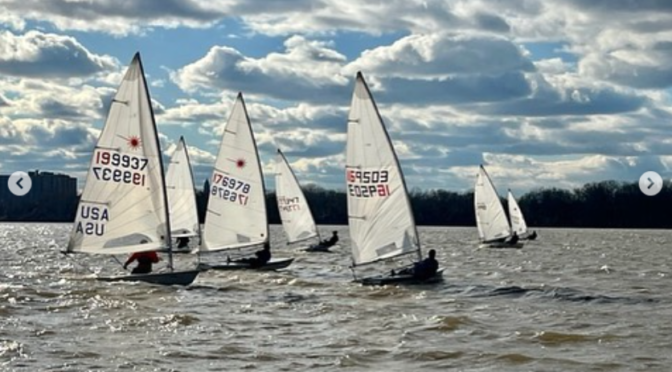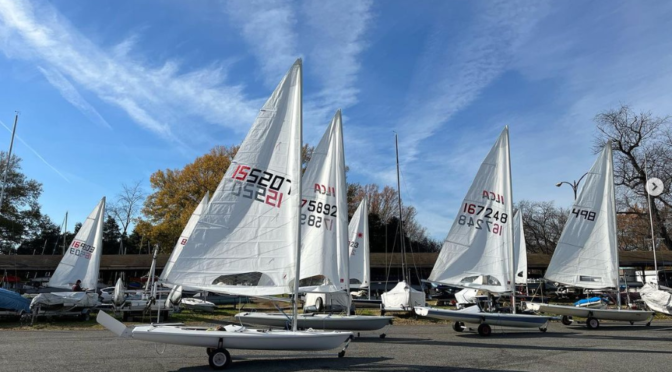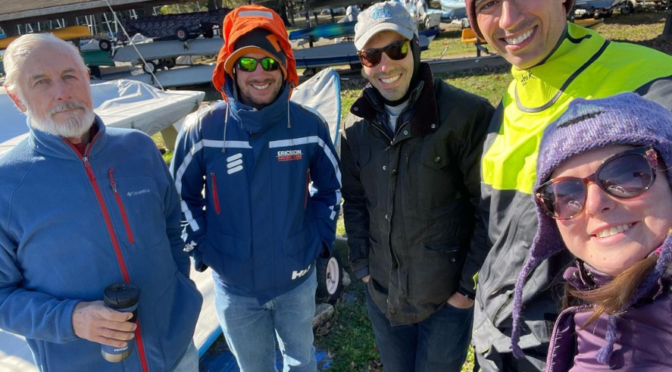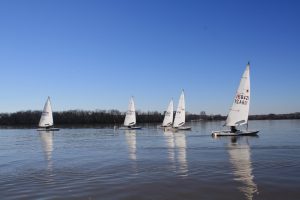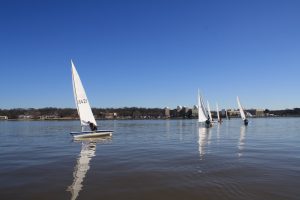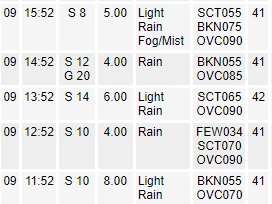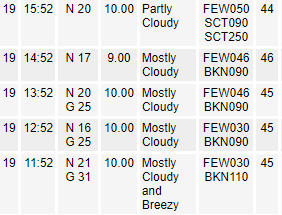I have the honor to be writing as your third place finisher, a result of nothing but fortitude. Seriously. So, here’s my take on the race. First, a thank you to Laura and Jim for setting a perfect course. It had a windward mark, a reaching mark and a downwind mark. Right distance and geometry. It started windy, out of the West, and continued to build, which favored those who stayed upright and made fewer mistakes. For example, I dropped multiple places by capsizing, hitting a starboard boat, undershooting the windward mark, and almost rear-ending Farley going close to 30 knots. I sailed the last race with Farley, netting both a second place and a DFL. Overall, great wind and weather and nice to be on the water, although we missed one of the great World Cup Finals of all time.
Category Archives: Series
Spring, Fall, Wednesday night, and Frostbite Series
2022-2023 Laser Frostbite #4
After 3 weeks of no sailing for various weather states, we finally got a nice Sunday to sail. It was sunny with temps in the mid 40s. And the weather brought a great showing of sailors with 21 boats coming to sail.
Sadly the wind did not get the memo for the day. It was very challenging for both Race Committee and the racers. Nabeel and Kevin did an excellent job trying to keep up with the wind. We were able to get 5 races in. We had 2 races with shortened courses and 3 course adjustments. The wind was quite shifty with a lot of velocity changes. We had a few points where there was full hiking conditions and several where we were drifting. But all in all it was nice to be out on the water.
As far as sailing, I think we all need to ask Laura for the tips as she was the post consistent sailor out there. But I found that moving forward of the cockpit in the light wind and then moving back as it came back up I moved back to a normal position. With all the velocity shifts, I found that I was playing the cunningham more than usual to try and keep the sail looking full and not overly tight at the luff. Other than that it was mostly just the usual things, get a good start, find clear air on the downwinds, and stay patient in the lulls.
It was great to see the turnout and I look forward to seeing everyone out next weekend!
2022 Laser Frostbite First Weeks Update
Well Sailors, after 3 weekends in a row of cancelling, we hope to finally get out and race this coming weekend.
Frostbite Series 1 (Nov 13) was too windy. Two souls made it to the race course with several capsizing on the way and others waiting on shore.
Frostbite Series 2 (Nov 20) was also windy. And the high of 38 gave us January Frostbiting weather in November. And with a lot of wind for the weekend and low tide, there was not much water in the river. Three brave souls showed up to try and race but ultimately pulled the plug.
Frostbite Series 3 (Nov 27) was rainy and a strange forecast of 9 gusting to 33 with a small craft advisory. 6 sailors showed up but only two were gung ho to go out and ultimately we decided that it was not worth punishing the race committee for two of us to go sailing.
Next weekend is a new day and hopefully we will get out and finally do a few races!
2021-2022 Laser Frostbite 11
David Metcalf and Carlo Sdralevich ran the races. It was their first time doing it. Thank you!
The wind was generally over 10 mph and relatively steady. The last race the wind picked up briefly to over 15 – no whitecaps but close. The racers were beating block-to-block for the most part, and they enjoyed the relatively steady wind. Some looked worn out by the 5th race, I know I would have been.
The low tide was lower than usual and setting a course in line with the wind in the deep parts of the river was challenging. For most of the races the pin end of the starting line was favored, the best starts were made from the middle of the line, away from traffic. Tom Hutton got in a groove and finished 1-1-1 in the last three races.
— Dave Metcalf
Results (Race 31-35)
LaserFrostbite2122_11
2021-2022 Laser Frostbite 10
It had been a while. We could not race for three consecutive Sundays due to icy ramps and ice on the river. So although the wind was very light and current was a factor, the “we will do this” RC and six intrepid sailors hit the water and got in two races.
Kaitlyn Lucey and Dan Miller were the RC.
Photos by Kaitlyn.
Results (I understand managing the current was the key):
2021-2022 Laser Frostbite 6
Gray day with a soft rain and a southwest wind in the 10-15 mph range. Air and water temperature both around 41.
John Van Voorhis and Jim Graham ran the races.
Day’s Results
LaserFrostbite2122_6 (races 26-28, January 9)
Thoughts from Farley —
Sunday was an interesting day on the river. The front mostly came in as expected and the wind built throughout the 3 races. It was a little different though because while the wind built, it continued to be mostly a southerly. The wind did generate some waves that were definitely surfable and it was still kind of puffy. Each race the wind built and started around 10 and was definitely gusting above 20 by the last race. Oh and it was raining the whole time. A huge thanks to Jim and John for doing race committee on a nasty day and putting a triangle mark to give us olympic courses!
For myself, I was struggling a bit with my first day out on the laser with high wind in basically 2 years (last year was decidedly not windy for the days I sailed). The first race I started near the pin and that did not work too well for me since the course was starboard tack and boat favored (I was running late and did not check anything). I did have some fun downwind tactics in the first race with Ethan where I was able to use the waves and wind to pass him on the inside right before rounding the leeward mark. The second race the wind had picked up a little more and I was starting to get overpowered. I snugged up my vang, outhaul, and cunningham to depower and stopped sheeting in quite as much. I got a little lucky and passed some people that capsized in that race. Some people went in for the last race. In the last race, it was getting windy. This was my “bad” race. I got stuck in irons 2 times during tacks and capsized 3 times during the race and was generally exhausted by the end (and glad it was the last race). For the stuck in irons, I did not think my vang was on too hard but I let it off and got the boat moving again before resetting.
All in all it was still a fun day but definitely harder than I was ready for!
So far this season, 30 boats have sailed and 15 have sailed half or more. Farley is learding the qualifiers, but Steen is way out front among the non-qualifiers and is likely to reach the quali fying threshold.
Cumulative Results Through #6
2021-2022 Laser Frostbite 5
Jim Klein and Kevin Cowley ran RC. They and the sailors had a long discussion about whether it was safe to go out. In the end they and 11 sailors did go out.
The winds where in the high teens (white caps were not constant) and gusts were up in the 20s. The air and water temperatures were similar — mid 40s. Colds hands were an issue for several sailors — we need to compare our methods of keeping hands warm. Capsizing and hard hiking was tiring.
Conditions at Reagan National Airport:
Results:
Thoughts from Mike Renda
Well, the wife took the kids and went to NY this morning, and the weather forecast was for 45F and gusts in the low 20s. Seemed like a good day to get out and go sailing. Anyways, some thoughts.
On the water, my mantra is this on days like this: 90% fast, 100% of the time. In general, this focuses on minimizing mistakes, avoiding problematic situations and risk, thinking ahead, and keeping good boat speed.
Racecourse: My general observation is that I think there were better puffs out left. Current didn’t really seem to be a factor, or at least I didn’t really think about it. There were small gains on shifts to be had, but tacking on them required a bit of calculation to determine if the shift was big enough to warrant the extra tack (tacking too much on a breezy day can be slow, and the course wasn’t really long). I believe most of my first beats were: start at boat, go left until near port layline, tack on port, tack back on starboard when on layline with about 2-4 boatlengths to the mark.
Pre-start: I believe the boat was increasingly favored throughout the day (though never that much). My general approach on days like this is to err on being near the boat, with a focus on getting off without a hitch (low risk). Vang should be loose in case you need to duck / maneuver, though drastic moves should be avoided — no gybing. Also, I try to keep my head out of the boat a bit and avoid starting near crowds of boats (again, trying to avoid big problems). Outhaul & cunningham should be set for upwind mode (in lighter breeze I’ll start with them looser). Finally, on these breezy days, when the fleet sits and waits for the last 30 seconds, nobody ends up quite on the line, as everyone drifts downwind and gets going too late. Trim up a touch early and take advantage.
Upwind: In general, vang was at least two-blocked, outhaul near the end of the boom, and cunningham pretty much as tight as you can get it. Once going, I try to keep the main two-blocked as much as possible, easing in the puffs when needed. Body position, I’m focusing on getting my weight outboard and forward to keep the bow down. The laser does really poorly when healed up, and you should really do whatever you can to avoid the big heels in the puffs. I also focus on trying to keep the bow knuckle touching the water. Every time the bow gets picked up by a wave, you’re getting tossed off the wind, losing forward progress. I also think it’s important to find a body position that you can hold for most of the leg rather than be consistently resetting. Once you’re set, your head can focus on the sail, boats around you, and the puffs. When the sail gets really flat on days like this, the groove gets really narrow, so I find that getting set bodywise can help eliminate a variable and allows me to more easily find the groove via the rudder and mainsheet.
Windward mark: It’s really important to be able to ease and turn the boat downwind at the windward mark. Get your vang off early (do what you can to make this happen). Having the vang line tied to the centerboard is a really good idea, as you can more easily reach it when hiked (and the end never ends up to leeward). As I approach the windward mark, I reach down at the mainsheet block and make sure I can let the mainsheet slide through my hand as I raise it up above my head. This ensures I can ease the mainsheet a good 6 feet as I turn downwind without hitting any knots. Once turned downwind, I always tighten the hiking strap — this is extremely important. Once tight, wrap your aft leg around it (when on starboard, this is your left leg). This will help you physically control the boat through the waves with your bodyweight, as you are effectively tying yourself to the boat.
Downwind runs: With your aft leg wrapped around the hiking strap, your front leg / knee can be used to help get the boat up on waves. Lean forward, put your knee on the diagonal part next to the centerboard slot, and lean back once your boat hops up on the wave. I thought the runs were particularly well aligned to the waves for small periods of surfing. I did a bit of the “wave carving” business, but I’m not very good at it, and again, safety / stability is a paramount concern. It’s important to be looking backwards every 15 seconds or so to look for puffs.
Leeward mark: Get your boat setup for the upwind leg. Board down, cunningham tight, vang tight, outhaul tight, hiking strap back to loose. Turn the boat upwind (even if you don’t have the main trimmed) right at the mark so that you’re in as high of a lane as possible (“wide, then tight”).
Final leg strategy: If you round right behind someone, tack off and make them cover. Stress them out and make them make mistakes in the breeze. If they’re responding to your move, they’ll never tack as well as they can. This applies on light air days as well.
Between races, I’m always thinking about how I get the blood flowing again. Hiking contorts your body up and limits blood flow to the legs. I think it’s important to stand up between races and get the blood moving around. Pro tip: Leave a thermos of hot chicken noodle soup on the committee boat for between races. Be sure to provide RC with beer afterwards.
Nice racing Steen, and thanks to Jim & Kevin for RCing. Good seeing everyone, and happy holidays to all.
2021-2022 Laser Frostbite 4
Greetings from 3rd place. Sunday was a bit of an odd wind day – it was from the northwest and the difference between the puffs and lulls was more than usual. Many folks flipped at one point or another (myself included), but we all thankfully ended the day back on shore mosty in one piece. Many thanks to Farley and Celeste for running the races!
It was nice to switch things up and have a jibe mark for a few races. I found generally staying high-ish on the reaches to be pretty fast – and a few times, I was able to pass a boat or two to windward at the leeward mark by being a little patient and making sure that my rounding was tight.
In terms of upwind strategy – there were fewer opportunities for tacking with shifts than expected in part because the mark was pretty far right and in part because often a seeming shift was just a lull, not an actual shift. As the afternoon wore on, I found myself waiting a few seconds to see whether it was worth tacking instead of continuing on my current course.
In terms of controls, I had my cunningham and outhaul pretty much max strapped for the first few races and then eased them just a tad in the later ones and during the less windy periods, especially downwind. Vang was 2-blocked or 2-blocked plus pretty much the entire day going upwind – and then loosened just before the windward mark in preparation for going downwind (and then adjusted tighter or even a bit looser depending on the puff situation). If you weigh more than I do, you probably didn’t need to tighten everything quite so much.
Overall, it was fun day and really great to have so many folks out there!
— Laura Windecker 167248
(Actually Laura was 2nd because she won the tiebreaker with Ethan — she had a 1st in race 2)
Results:
LaserFrostbite2122_4
(Races 16-21)
2021-2022 Laser Frostbite 3
Another pleasant day, probably the lightest of the three we have had so far. Laura Windecker and Steen Byskoff ran the races and had to reset the marks a couple of times.
The light breeze was from the ESE with occasional puffs that could make you look like a genius or destroy you if is missed you. The current was going out strong and pushing us over the line. We had a general recall and some OCS boats who did go back.
21 boats came out. Nice!
Ethan was third. Ethan, do you want to write something up about what you did?
Results:
2021-2022 Frostbite 2
A beautiful day with light winds from the SSW. Brian Joseph ran the races.
(With the 15 boats that raced today and the 19 that raced last week, we have had 25 boats come out. )

